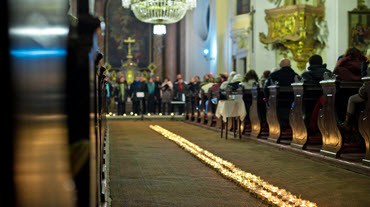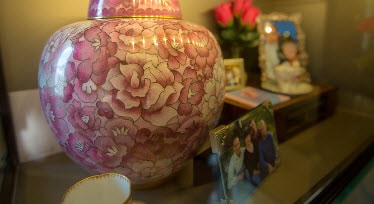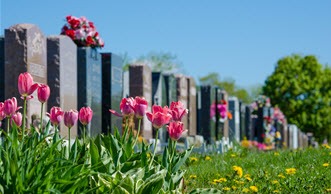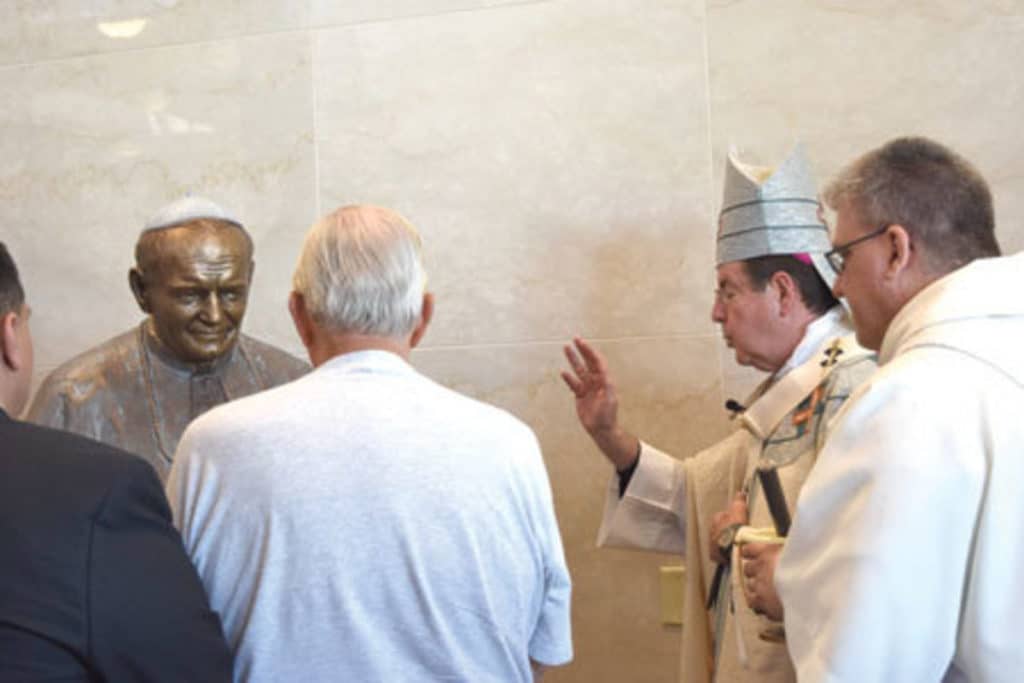 Archbishop Vigneron pauses to bless a life-size statue of St. John Paul II inside the new mausoleum.
Archbishop Vigneron pauses to bless a life-size statue of St. John Paul II inside the new mausoleum.
Brownstown Township — Outside of churches, cemeteries are the most sacred places in the Church.
With cemetery staff and loved ones of those who’ve passed on to the next life in the congregation, Archbishop Allen H. Vigneron spoke of the importance of cemeteries during the June 18 dedication Mass of the new St. John Paul II Mausoleum at Our Lady of Hope Cemetery in Brownstown Township.
The new chapel will serve as the cemetery’s indoor mausoleum, complementing the outdoor mausoleum the cemetery has near the entrance of the grounds.
The archbishop referred to cemeteries as the “gateways” to heaven, a transition point between a person’s time on Earth and being called up to heaven.
Before blessing the altar, Archbishop Vigneron reminded the congregation that it’s the same altar at which their loves ones were baptized, confirmed, received Communion, where married and ultimately, were buried, since Jesus Christ unites them all.
“It’s right to read Scripture, to read about what God has said, regarding what we will see and do in a few minutes,” Archbishop Vigneron said. “This building is more than a room or auditorium, it’s a chapel with an altar. This chapel is where the sacraments happen on this altar. Isaiah writes that God destroys death forever on the altar. But this altar is the same as the one in Jerusalem, because Jesus Christ made all altars Jerusalem through his death.
”After Mass, Fr. Tim Babcock, liaison for the archdiocesan cemeteries and a board member of Catholic Funeral and Cemetery Services of Detroit, thanked staff and planners who worked on the four-year project, complete with a life-size bronze statue of St. John Paul II and a stained-glass window from now-closed Our Lady of Lourdes Church in River Rouge, a nod to the Downriver
Fr. Tim Babcock, liaison for the Archdiocese of Detroit’s Catholic Funeral and Cemetery Services, speaks during the June 18 dedication of the St. John Paul II Mausoleum at Our Lady of Hope Cemetery in Brownstown Township. Behind him is a stained glass window transported to the new mausoleum from the now-closed Our Lady of Lourdes Church in River Rouge.
Photos by Dan Meloy | The Michigan Catholicfamilies who remember worshipping at the parish.
“This is a historic, momentous day for Our Lady of Hope Cemetery,” Fr. Babcock said. “On behalf of all those who worked on this project, providing sacred, beautiful rest to the loved ones buried here and all who visit who feel that rest, we hope you find the peace we look to provide.
”During the Mass, the archbishop sprinkled holy water on the altar and statue — pausing to stare into the statue’s eyes and pray — and circle the building, dosing the outer walls with holy water.
Follow Mass, the congregation was invited to an outdoor reception to celebrate the dedication of the mausoleum.
“Four years ago, Fr. Babcock had the idea for this chapel,” said Deanna Cortese, location manager at Our Lady of Hope Cemetery. “We have an outdoor mausoleum, but it’s at capacity. We needed to provide more space and have an indoor mausoleum, so Fr. Babcock led the way with how it should look.
”Along with statue, the mausoleum features glass niches where loved ones can commemorate peoples’ lives with pictures, small statues or mementos, all of which help them find closure and serenity when visiting, Cortese said.
Our Lady of Hope first opened the mausoleum on Mother’s Day for people to come and see the chapel, and Cortese said around 200 people visited.
“It’s such a beautiful place for people in the Downriver community to come to be laid to rest, and there is so much history with Our Lady of Lourdes in the area,” Cortese said. “People comment on seeing the window when they were younger, so it’s great to incorporate it into the design of the chapel and have the window in the Downriver community where it belongs.”

 Memorial service part of National Day of Remembrance for Aborted Children, one of 180 such services held nationwide
Memorial service part of National Day of Remembrance for Aborted Children, one of 180 such services held nationwide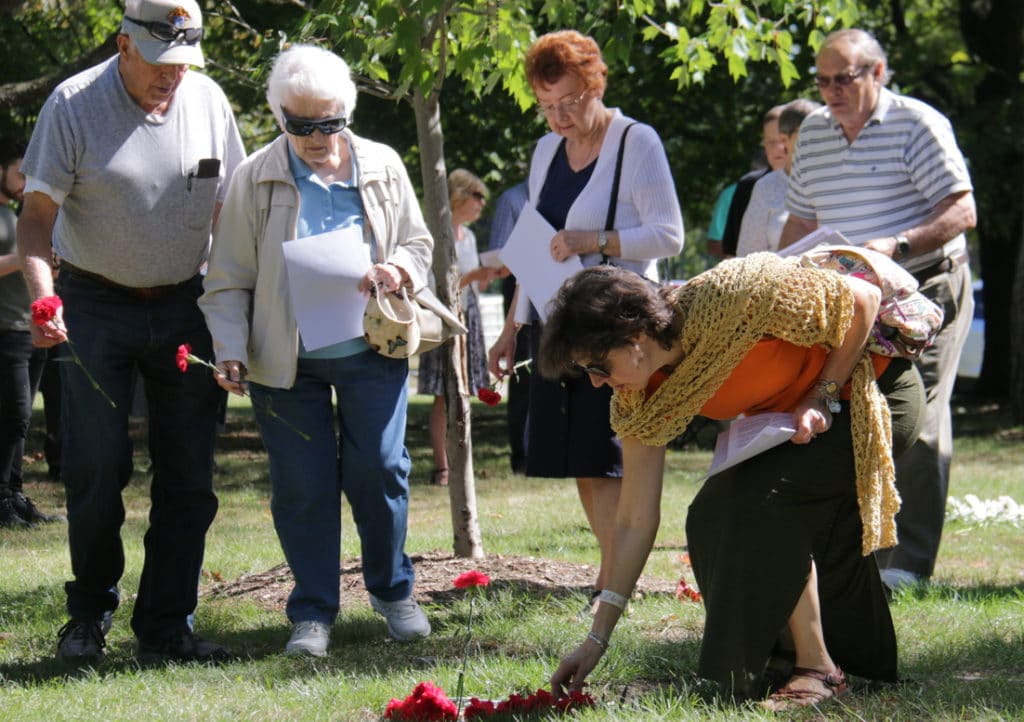 Still, all those who suffer indignity are united with Christ in his blood on the Cross, Miller added.
Still, all those who suffer indignity are united with Christ in his blood on the Cross, Miller added.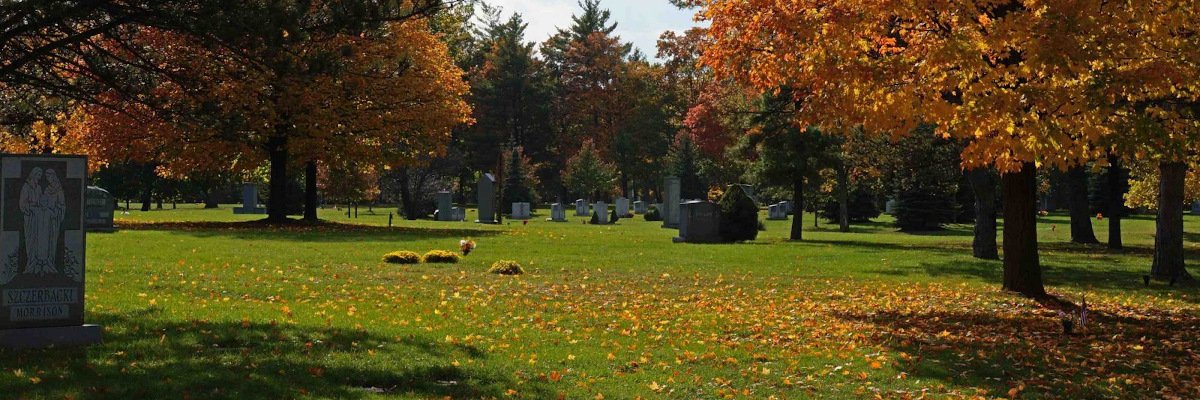 On the evening of September 13, Holy Sepulchre Cemetery is set to honor Blessed Solanus Casey with a new cemetery section that will bear his name. Bishop Donald Hanchon will dedicate the new Blessed Solanus Casey section and an hors d’oeuvre reception including wine from the Bishop’s Vineyard will immediately follow.
On the evening of September 13, Holy Sepulchre Cemetery is set to honor Blessed Solanus Casey with a new cemetery section that will bear his name. Bishop Donald Hanchon will dedicate the new Blessed Solanus Casey section and an hors d’oeuvre reception including wine from the Bishop’s Vineyard will immediately follow. At the wine tasting event, Holy Sepulchre will share information about its unique mission program. The Catholic Funeral & Cemetery Services Blessed Solanus Casey Endowment Fund provides financial assistance to bury the ashes of unclaimed remains, as well as for burial plots for unclaimed remains at no cost. In addition, the fund will provide no cost burials for children under the age of two, including miscarriages. This program highlights Holy Sepulchre’s commitment to help the greater community.
At the wine tasting event, Holy Sepulchre will share information about its unique mission program. The Catholic Funeral & Cemetery Services Blessed Solanus Casey Endowment Fund provides financial assistance to bury the ashes of unclaimed remains, as well as for burial plots for unclaimed remains at no cost. In addition, the fund will provide no cost burials for children under the age of two, including miscarriages. This program highlights Holy Sepulchre’s commitment to help the greater community. At age 13, James Williams was facing $9,000 in expenses.
At age 13, James Williams was facing $9,000 in expenses.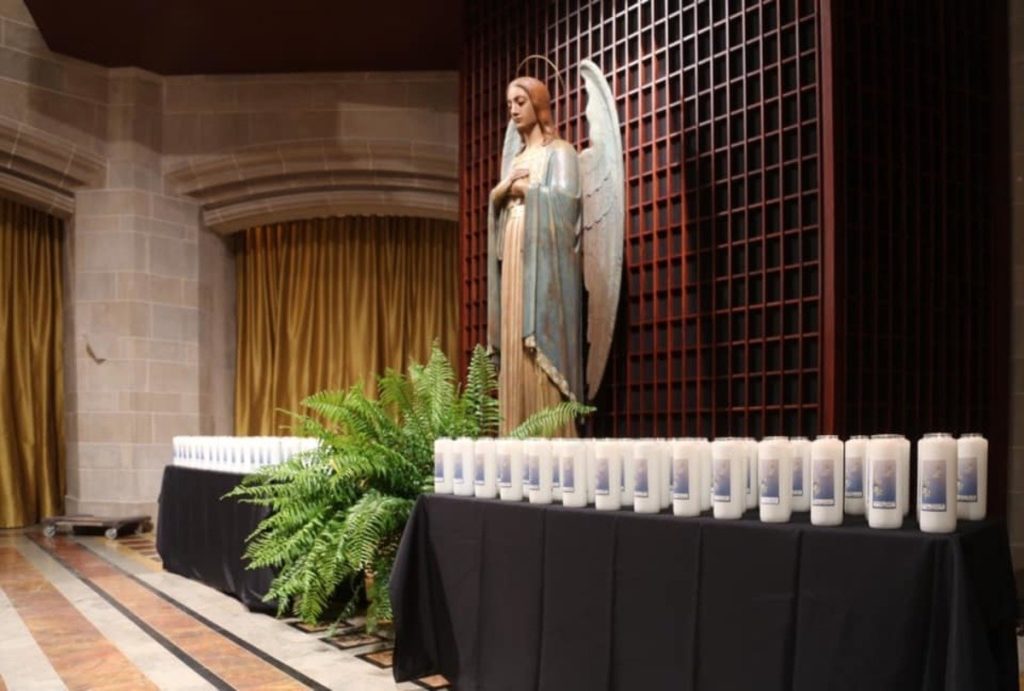 During All Souls Mass celebrated especially for those lost to COVID-19, bishop reminds faithful that praying for the dead is an act of charity
During All Souls Mass celebrated especially for those lost to COVID-19, bishop reminds faithful that praying for the dead is an act of charity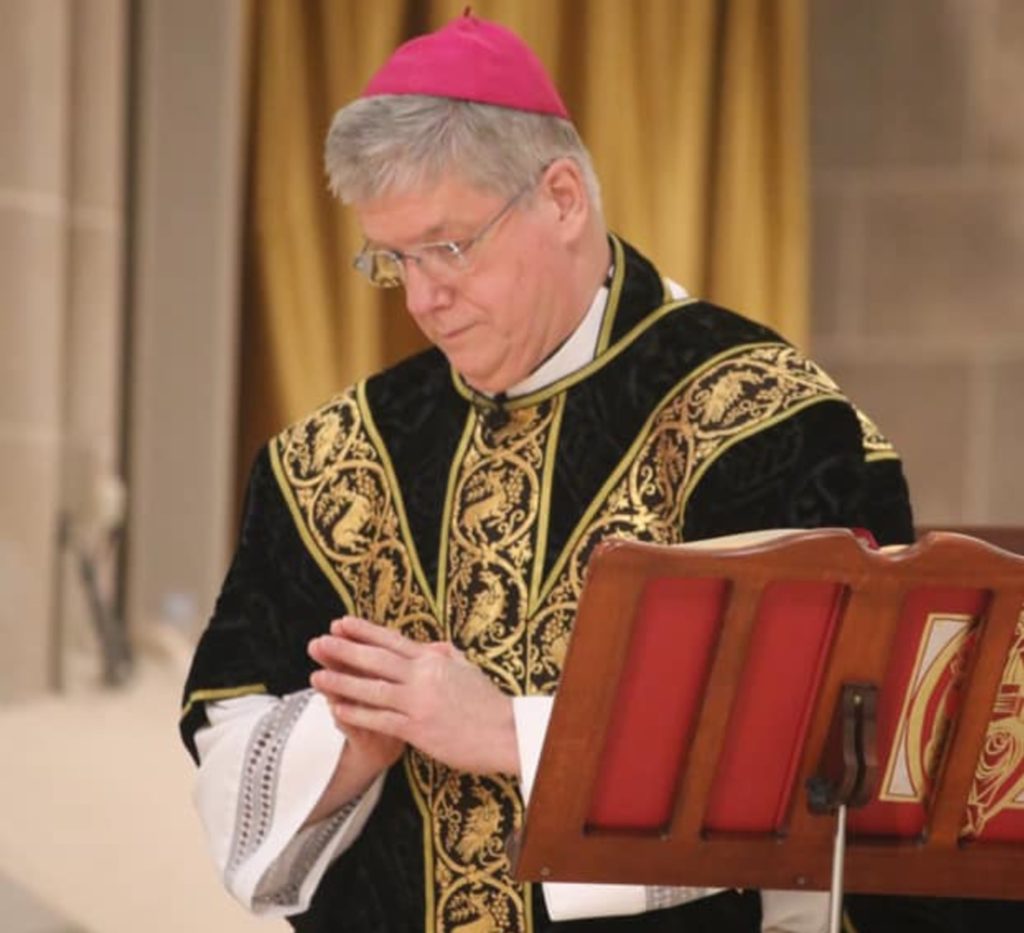
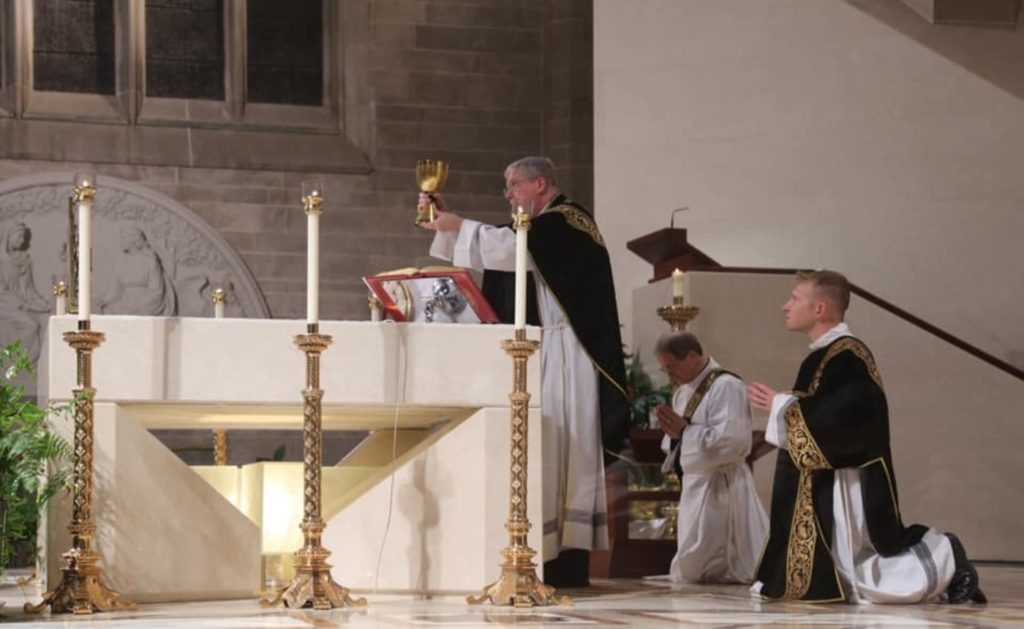
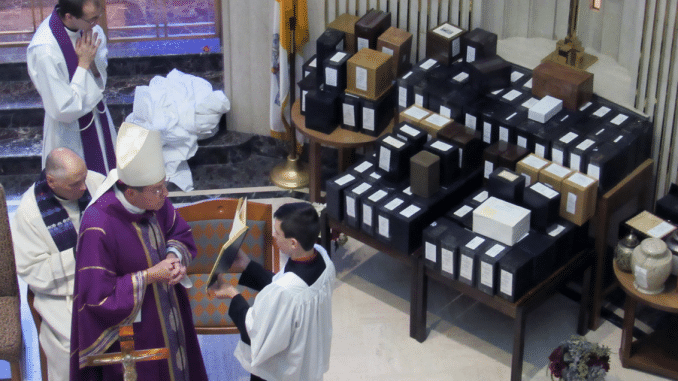 MADISON, Wisconsin — Bring them home to holy ground for All Souls Day.
MADISON, Wisconsin — Bring them home to holy ground for All Souls Day.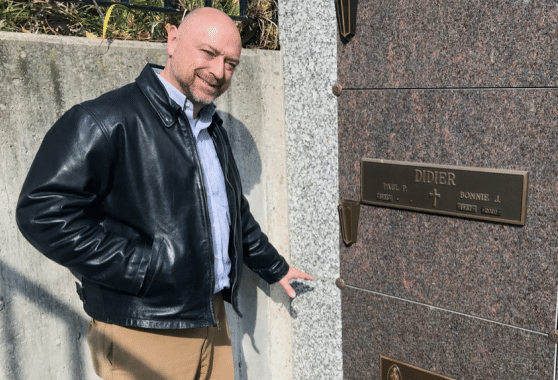 Lenshek said cremation removes the practical need for burial immediately after the funeral. “You lose the urgency. There’s an urgency to burying a body, and I think that’s good,” he said. “The pace of the decomposition of the body and the stages of grief, I think there’s a parallel there. It’s good for us, you’re not rushing through it but you’re stepping through it, and you put the body in the ground. It’s a corporal work of mercy and there’s an urgency that attaches to corporal works of mercy.”
Lenshek said cremation removes the practical need for burial immediately after the funeral. “You lose the urgency. There’s an urgency to burying a body, and I think that’s good,” he said. “The pace of the decomposition of the body and the stages of grief, I think there’s a parallel there. It’s good for us, you’re not rushing through it but you’re stepping through it, and you put the body in the ground. It’s a corporal work of mercy and there’s an urgency that attaches to corporal works of mercy.”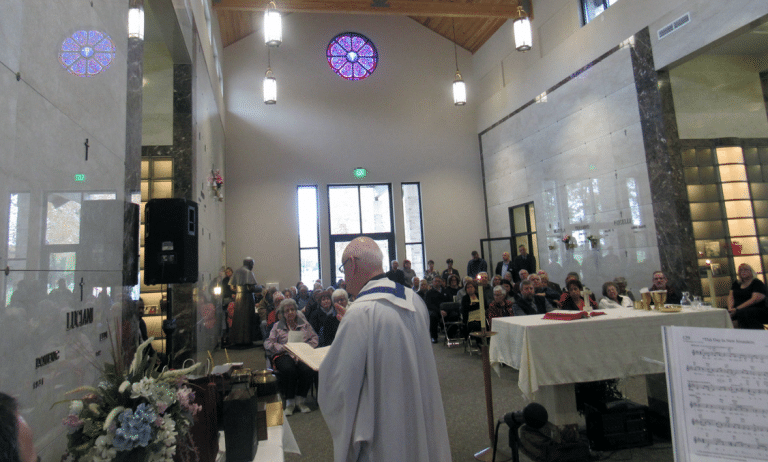 The rise in cremation rates stands in stark contrast to declines in many key Catholic demographics. Since 1999, the number of infant baptisms in the United States has fallen nearly 42 percent, according to the Center for Applied Research in the Apostolate (CARA) at Georgetown University. The number of marriages declined even more — 47 percent — during the same period. Catholic funerals declined 17 percent, the number of parishes dropped 12 percent and Sunday Mass attendance dropped 32 percent. The only category with a major increase was in people who self-identify as “former Catholics.” That number skyrocketed, from 3.5 million in 1970 to 29.4 million in 2019.
The rise in cremation rates stands in stark contrast to declines in many key Catholic demographics. Since 1999, the number of infant baptisms in the United States has fallen nearly 42 percent, according to the Center for Applied Research in the Apostolate (CARA) at Georgetown University. The number of marriages declined even more — 47 percent — during the same period. Catholic funerals declined 17 percent, the number of parishes dropped 12 percent and Sunday Mass attendance dropped 32 percent. The only category with a major increase was in people who self-identify as “former Catholics.” That number skyrocketed, from 3.5 million in 1970 to 29.4 million in 2019.